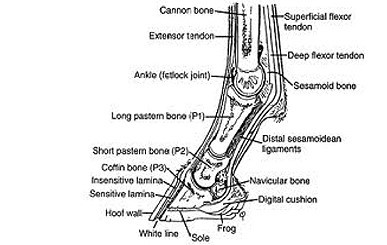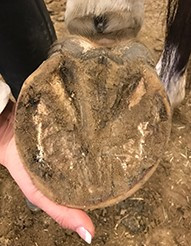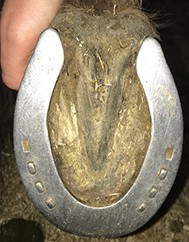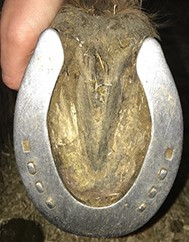By Heidi Carroll
South Dakota State University is home of a competitive National Collegiate Equestrian Association (NCEA, an affiliate of NCAA) Equestrian team. For this university sport, the Nathelle and Lawrence DeHaan Equestrian Center houses about 30 horses, year-round. The school is responsible for providing quality care for all of these horses. One major aspect of caring for equine athletes is hoof care.
On average, horses require their feet to be trimmed and shoes to be reset every six to eight weeks because the horse’s hoof is constantly growing. The average horse hoof wall grows at a rate of 0.24-0.4 inches per month. Age, season, moisture, exercise, and nutrition can all affect the rate at which a horse’s hoof grows. For example, hoof growth tends to slow in the winter and accelerate in the spring (Briggs, 2002).
Finding the Right Farrier
Levi Hanten shoes all of the Equestrian team’s horses. When finding a new farrier, Equestrian team barn manager, Rachel Boone, suggests bringing a farrier in on ‘trial’ and observing how they work. Can they keep all of the horses sound? “A farrier with patience with the horses is very important,” said Boone. It is ideal for the equestrian team’s farrier to have good horse skills, and have the ability to handle some horses that may not enjoy having their feet done. “We are lucky to have a farrier that is able to cater to all of our different horses’ needs,” said head coach Ellie Wilkins.
Shoeing Basics
Many horses are able to be without shoes, especially those only worked lightly on nonabrasive footing. However, many horses benefit from the extra stability and relief that the shoes provide. Shoes can help protect the hoof from excessive wear, and also provides traction. In some cases, shoes can aid the horse’s soundness by adding an extra cushion or adjusting the alignment of the limb bones. Shoes are attached to the hoof by nailing through the hoof wall (insensitive area without blood flow) shown in Figure 1, but can also be glued on in certain cases.
Keg shoes are a very common type of shoe that are machine-made. These shoes are available in various shapes and sizes and typically made of steel. The farrier is able to shape the shoe to fit the foot by using an anvil and forge. Aluminum shoes are also commonly worn by the equestrian team’s horses. Aluminum is softer than steel and absorbs more impact. These shoes are much lighter, which make them a great option for horses that have a weak hoof wall and have trouble keeping a steel shoe on. Aluminum shoes also have more nail holes allowing the farrier to place the shoes more precisely, and giving more of a custom fit.

Fig.1. Anatomy of the lower limb of the horse.
What do the equestrian team horses wear?
The SDSU Equestrian team horses vary greatly in their farrier needs, from horses that are able to remain barefoot, to horses that are recovering from injuries that require custom shoes. Although about 1/3 of the team’s horses are able to remain barefoot year-round (Figure 2), the majority of the horses have keg steel shoes (Figure 3).
The equestrian team primarily has their horses on an eight-week shoeing schedule. Some horses get their feet done every four weeks because they have feet that grow faster or they need to have their angles kept within a narrower range for maximum performance.

Fig. 2. Approximately one third of the team’s horses are able to comfortably remain barefoot.

Fig. 3. The majority of the team’s horses wear keg steel shoes fit to their hoof shape.
Discipline Considerations
The SDSU Equestrian team competes horses in four different disciplines: equitation over fences, equitation on the flat, horsemanship, and reining. The traction needs for the different horses in each discipline can vary. For example, the reining horses require specific shoes for their discipline. These horses wear shoes that are commonly called sliders (Figure 4 and Figure 5). This type of shoe is only worn on the hind hooves to provide assistance in the sliding stops, which are required in a reining pattern.
Sliders are typically wider than the average horseshoe, and have a “rocker toe”, which means the toe of the shoe is built to tip upward. These shoes also have a longer heel, which is slightly turned out to aid in sliding and provide further support. Head reining coach, Raivenne Scott said, “Having sliders on our reiners definitely makes a significant difference in their ability to perform a correct sliding stop.”

Fig. 4. Sliders have a longer heel, which is slightly turned out to aid in sliding and provide further support.

Fig. 5. Side view of a slider.
Special Cases
Managing caudal heel pain
One of the team’s horses has caudal heel pain, also known as navicular syndrome. Caudal heel pain often begins with inflammation of the bursa between the deep digital flexor tendon and the navicular bone of the foot (refer to Figure 1), is a common cause of lameness in horses. Corrective shoeing is helpful for caudal heel pain, and in many cases provides the ability to reduce pain and extend the horse’s useful service.
Click here to see more...